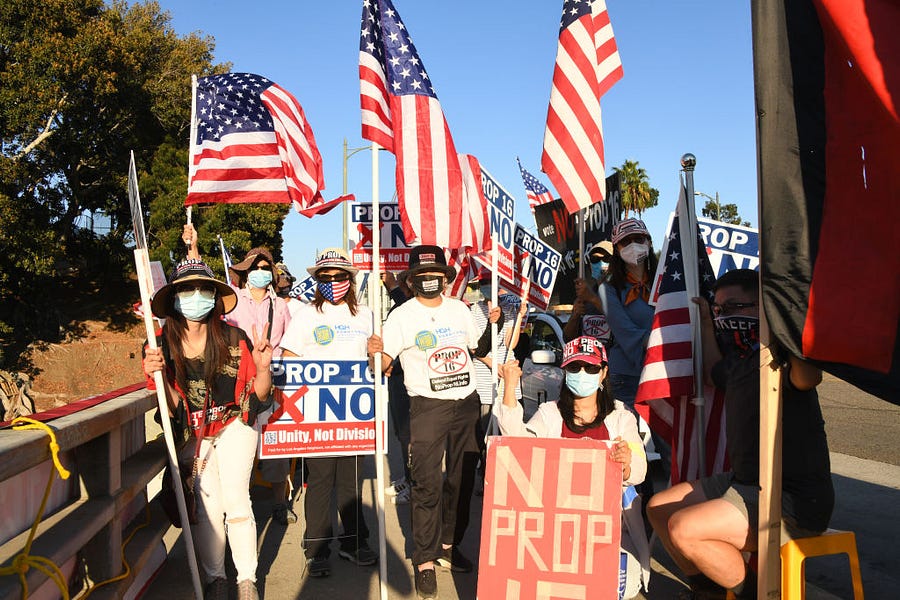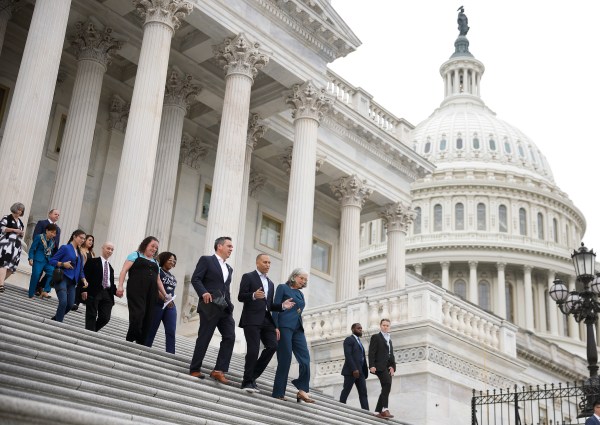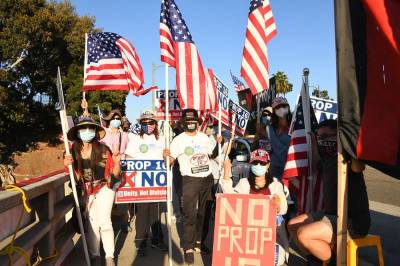In June, California lawmakers felt that the time was right to end the state’s longstanding ban on affirmative action, created by a ballot measure in 1998, Proposition 209. Rep. Shirley Weber, introducing Proposition 16, said “The ongoing pandemic, as well as recent tragedies of police violence, is forcing Californians to acknowledge the deep-seated inequality and far-reaching institutional failures that show that your race and gender still matter.”
Given the mood at the time—George Floyd’s death at the hands of Minneapolis police prompted protests around the state—as well as California’s liberal electorate, lawmakers could be forgiven for thinking that the odds of overturning Proposition 209 were very much in their favor.
But California voters appear poised to reject the ballot measure on Election Day. One of the last major victories for conservatives in California looks like it will be upheld by an electorate that has shifted markedly to the left since it was enacted. Polls from the Public Policy Institute of California, a nonpartisan research center, show that only 37 percent of likely voters support the measure, with 50 percent against and 12 percent undecided. For the “yes” side, this is only a modest improvement on polls taken in September, which showed 31 percent of voters for and 47 percent against.
It’s not for a lack of support from prominent figures. At the federal level, Kamala Harris, Diane Feinstein, and Nancy Pelosi have endorsed the measure. Gov. Gavin Newsom, who is very popular in the state, has also said he supports 209’s repeal. Some of the state’s largest papers (the San Francisco Chronicle, the Los Angeles Times, the San Diego Mercury News, and the Sacramento Bee) have also all officially endorsed a “yes” vote.
The measure is also endorsed by the University of California Board of Regents. The U.C. system, which has an enrollment of roughly 285,000 students, has done its utmost to get around 209’s mandates with a “holistic” admissions process that has been criticized as a backdoor for racial preferences. The Board of Regents’ recent decision to temporarily eliminate standardized test and minimum grade requirements, citing coronavirus concerns, is another move meant to undermine 209—proposals to eliminate the SAT in the admissions process began soon after Proposition 209’s passage.
So why the persistent opposition? To start with, Democratic leaders may have seriously overestimated affirmative action’s popularity with the broader public, even among liberals and racial minorities. While strong majorities favor affirmative action at the conceptual level and agree that companies should work to promote diversity, support plummets when poll respondents are asked if they favor race as a factor in making hiring decisions.
In California, this divergence between the public’s view from 30,000 feet and their actual policy preferences has helped Proposition 209 survive several legal and legislative challenges over the years. As Kenneth P. Miller, a professor at Claremont McKenna College in Southern California and associate director of its Rose Institute of State and Local Politics, tells The Dispatch, many otherwise progressive voters “might not be on board with eliminating 209 … if they think this change in policy would disadvantage their kids’ chances of admissions for the U.C. system.” With U.C. admissions growing more competitive by the year, it is difficult for many voters to support a bill that they perceive as directly disadvantaging their children.
This interpretation of the situation seems reasonable for white and Asian American voters. Asian American students made up 40 percent of enrolled freshmen from California in 2018, while constituting only 13 percent of high school graduates, making them the most “overrepresented” group in the system. Black students’ share of the freshmen population was similar to their high school graduate share, around 4.7 percent and 5.6 percent, respectively. Whites and Latinos are the groups most “underrepresented,” and Latinos the most by far: They make up 51 percent of high school graduates and 29 percent of freshmen.
Miller noted that any large shift in the numbers of black and Latino students would almost certainly come overwhelmingly at the expense of the system’s Asian American cohort, which could help explain the reluctance of many left-leaning Asian American voters to support Proposition 16.
But Proposition 16’s success or failure could come down to how a less-discussed ethnic group votes: Latino voters, who recently passed whites as the largest ethnic group in the state and who stand to “benefit” the most from affirmative action, as least as it pertains to university admissions. But Latino support for the bill is similar to anemic white and Asian-American support: 37 percent, in the October survey of 1,136 likely voters by the PPIC.
At first glance, this lack of enthusiasm could be viewed as a piece with President Trump’s surprising gains with Latino voters nationally, especially with men. But some experienced California political analysts caution against that analysis.
Mike Madrid, a Republican consultant and widely respected expert on Latino voting trends, said in an interview with The Dispatch that the Latino vote is “a ‘day of’ vote, it’s not a mail-in ballot vote, it’s not an early vote. … It looks for partisan cues.” He pointed out that in the original 1998 campaign for Proposition 209, Latino support for banning affirmative action looked strong early, then collapsed in the days before the vote. A Los Angeles Times poll in 1998 found that a week before the election, only 42 percent of Latinos opposed 209; 76 percent of Latinos ended up against the measure.
Daniel HoSang, a professor at Yale University and author of Racial Propositions: Ballot Initiatives and the Making of Postwar California, largely agreed with the assessment that the party identification of Latino voters in California would, in the end, be the strongest predictor of the final outcome at the polls. But he also noted that “as the Latino electorate grows, it’s going to be more internally diverse, and there’s no kind of reflexive support” for affirmative action, unlike many black voters, who, Hosang noted, view the policy as a stand in for “ a whole set of issues around equal opportunity, workplace discrimination, [and] education access.”
A poll of likely voters by the Institute for Governmental Studies at UC Berkeley found that from September to October, the Latino “yes” vote in support of Proposition 16 held steady at 40 percent, but the “No” vote increased from 33 percent to 42 percent. The PPIC’s poll had similar results, with “yes” at 41 percent in September and 37 percent in October, and “no” increasing from 41 percent to 48 percent.
But in both polls, nearly one-fifth of respondents were still undecided. The most telling statistic, then, might not be what Latino respondents say, but how Democrats say they’ll vote. The PPIC reports that 58 percent of California Latinos are Democrats, a higher proportion than white and Asian American voters. With the PPIC poll showing Democrats breaking heavily in favor of Proposition 16 as the election draws nearer, the strange case of anemic Latino support for affirmative action in California may simply be solved by last minute partisan signaling.
However, if Proposition 16 goes down in defeat, affirmative action’s supporters may have to face harsh truths for their side. Supporters have tried to explain its poor polling performance as a reflection of voter confusion and the measure being swamped by the proliferation of other initiatives on the ballot. Madrid and Hosang agreed with this analysis, at least for Latino voters, and given the high numbers of undecided voters in that group, they may have a point.
Miller, however, was skeptical about claims of confusion for Latino, and other, voters, saying, “I don't think it's that hard for most voters to sort out that California has had a ban on affirmative action and this would lift the ban … I think a lot of people just have pretty nuanced and thoughtful views on this topic.”
Instead, liberals may have to confront the fact that in the most progressive state in the union, with one of the most diverse electorates and a far more organized and endorsed campaign for “yes” than for “no,” Proposition 16 looks like it is headed for defeat. Unlike the polarizing ballot measures of the 1990s, with an embattled conservative electorate facing off against a rising liberal one, Proposition 16 seems set to be rejected by millions of Democrats quietly bubbling in the “No” on their ballot.
Photograph by Araya Diaz/Getty Images.







Please note that we at The Dispatch hold ourselves, our work, and our commenters to a higher standard than other places on the internet. We welcome comments that foster genuine debate or discussion—including comments critical of us or our work—but responses that include ad hominem attacks on fellow Dispatch members or are intended to stoke fear and anger may be moderated.
With your membership, you only have the ability to comment on The Morning Dispatch articles. Consider upgrading to join the conversation everywhere.